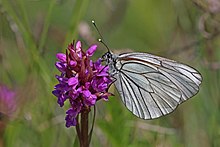
Back Witjie AF كرنبيات (حشرات) Arabic كرنبيات (فصيله من الحشرات) ARZ Pieridae AST Ağ kəpənəklər AZ آغ کپهنکلر AZB Аҡ күбәләктәр BA Бялянкі BE Белянки Bulgarian Pièrids Catalan
| Pieridae | |
|---|---|

| |
| Black-veined white (Aporia crataegi) male | |
| Scientific classification | |
| Domain: | Eukaryota |
| Kingdom: | Animalia |
| Phylum: | Arthropoda |
| Class: | Insecta |
| Order: | Lepidoptera |
| Superfamily: | Papilionoidea |
| Family: | Pieridae Swainson, 1820 |
| Subfamilies | |
| Diversity | |
| 76 genera 1,051 species | |


The Pieridae are a large family of butterflies with about 76 genera containing about 1,100 species, mostly from tropical Africa and tropical Asia with some varieties in the more northern regions of North America and Eurasia.[1] Most pierid butterflies are white, yellow, or orange in coloration, often with black spots. The pigments that give the distinct coloring to these butterflies are derived from waste products in the body and are a characteristic of this family.[2] The family was created by William John Swainson in 1820.
The name "butterfly" is believed to have originated from a member of this family, the brimstone, Gonepteryx rhamni, which was called the "butter-coloured fly" by early British naturalists.[2]
The sexes usually differ, often in the pattern or number of the black markings.
The larvae (caterpillars) of a few of these species, such as Pieris brassicae and Pieris rapae, commonly seen in gardens, feed on brassicas, and are notorious agricultural pests.
Males of many species exhibit gregarious mud-puddling behavior when they may imbibe salts from moist soils.[1]